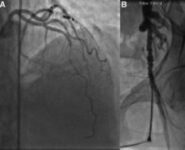Original title: Angiographic Success and Procedural Complications in Patients Undergoing Percutaneous Coronary Chronic Total Occlusion Interventions. A Weighted Meta-Analysis of 18,061 Patients From 65 Studies. Reference: Vishal G. Patel et al. J Am Coll Cardiol Intv 2013. Article in press. Chronic Total Occlusions (CTOs) are found in between 15% and 30% of patients undergoing coronary angioplasty. Successful CTOs…
Ambulatory Coronary Angiography: Is any further evidence required?
Original title: Same-Day Discharge Compared With Overnight Hospitalization After Uncomplicated Percutaneous Coronary Intervention. A Systematic Review and Meta-Analysis Reference: Eltigani Abdelaal et al. J Am Coll Cardiol Intv 2013. Article in press. Coronary angioplasty and subsequent same day discharge in selected patients can reduce costs and increase patient comfort. Several observational studies and a few randomized studies have…
Ischemic preconditioning reduces infarct size in patients treated with primary angioplasty
Original title: Preinfarction Angina Reduces Infarct Size in ST-Elevation Myocardial Infarction Treated With Percutaneous Coronary Intervention Reference: Ronald Reiter et al. Circ Cardiovasc Interv. 2013;6:00-00. Ischemic preconditioning (IPC) is a phenomenon whereby transitory ischemia episodes protect the myocardium against a more prolonged episode. Until now, IPC has been the most effective approach to protect the myocardium. Pre infarction…
The FFR improves outcomes in daily practice as in randomized studies
Original title: Long-term outcomes of fractional flow reserve-guided vs. angiography-guided percutaneous coronary intervention in contemporary practice. Reference: Li J et al. Eur Heart J. 2013; Epub ahead of print Precision of the fractional flow reserve (FFR) to estimate the functional compromise of coronary stenosis and its ability to reduce events to decide PTCA, based on their outcome has…
Radiation-associated Lens Opacities in Catheterization Personnel: Results of a Survey and Direct Assessments
The development of interventional cardiology has led us to successfully treat injuries and angiographic situations increasingly complex. This goes along that often the length of procedures is increasing automatically leading to increased fluoroscopy time and film images. The result, often unnoticed, is the possibility of the appearance of irradiation injuries in our patients or in…
The radial artery is the default access for Europe.
Original title: Consensus document on the radial approach in percutaneous cardiovascular interventions: position paper by the European Association of Percutaneous Cardiovascular Interventions and Working Groups on Acute Cardiac Care and Thrombosis of the European Society of Cardiology. Reference: Martial Hamon et al. EuroIntervention 2013; 8-online publish-ahead-of-print January 2013. The European Society of Cardiology (ESC) recently published a consensus…
Modest correlation between IVUS and FFR in intermediate lesions assessment
Original title: FIRST: Fractional Flow Reserve and Intravascular Ultrasound Relationship Study Reference: Ron Waksman et al. J Am Coll Cardiol 2013. Article in Press For patients with angiographically assessed intermediate lesions such as stenosis between 40% and 80%, criteria that favor revascularization remains under debate. Fractional Flow Reserve (FFR) is considered the gold standard to assess intermediate lesions,…
Spontaneous coronary artery dissection (SCAD) is associated with fibro-muscular dysplasia in other territories
Original title: Spontaneous Coronary Artery Dissection. Prevalence of Predisposing Conditions Including Fibromuscular Dysplasia in a Tertiary Center Cohort Reference: Jacqueline Saw, et al. J Am Coll Cardiol Intv 2013;6:44 –52 Non atherosclerotic spontaneous coronary artery dissection (Non atherosclerotic SCAD) is a rare disease that is associated with acute myocardial infarction and sudden death. This condition is more common…
Intracoronary enalaprilat reduces periprocedural injury.
Original title: Intracoronary Enalaprilat to Reduce Microvascular Damage During Percutaneous Coronary Intervention (ProMicro) Study. Reference: Fabio Mangiacapra et al. J Am Coll Cardiol 2013. Article in press Angiotensin converting enzyme (ACE) inhibitors improve clinical outcomes in patients with coronary artery disease and improve epicardial flow in patients with acute ST-segment elevation. Beyond the long-term protective effect of oral…
Periprocedural stroke, unrelated to the access site?
Original title: Influence of access site choice on incidence of neurologic complications after percutaneous coronary intervention. Reference: Karim Ratib et al. Am Heart J 2012;0:1-8 Article in press. Neurological complications post coronary angioplasty (PCA) are sporadic but they are associated with eight times increased mortality. A transradial approach has multiple advantages over femoral but could theoretically have a…
Thrombus Aspiration is useful in AMI
Original title: A Prospective Randomized Trial of Trombectomy Versus No Thrombectomy in Patients With ST-Segment Elevation Myocardial Infarction and Thrombus-Rich Lesion. MUSTELA (MUltidevice Thrombectomy in Acute ST-Segment ELevation Acute Myocardial Infarction) Trial Reference: Marco De Carlo, et al. J Am Coll Cardiol Intv 2012;5:1223–30 The main objective during primary PCI is myocardial reperfusion, which is limited by distal…










